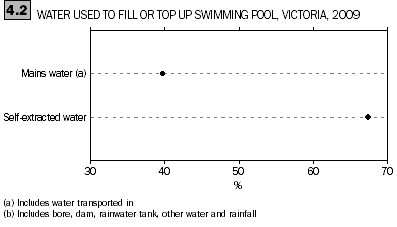 GARDENS AND SWIMMING POOLS
GARDENS AND SWIMMING POOLS
This chapter explores gardens and swimming pools at Victorian dwellings.
Due to ongoing dry weather conditions, Victorian water authorities have created drought response plans which are aligned under the Uniform Drought Water Restriction Guidelines by the Victorian Water Industry Association as directed by the Victorian government (DSE 2005).
Water restrictions have been in place in Melbourne since 2007. From April 2007 to April 2010, the restrictions were stage 3a. Under stage 3a water restrictions, gardens can be watered on specified watering days within specified times but lawns must not be watered at any time with drinking water (mains water). Rainwater (or grey water) can be used at any time. New or existing pools and spas cannot be filled or topped up without prior approval.
Areas of central and western Victoria, including towns such as Ballarat, Bendigo and Horsham, were on stage 4 water restrictions in 2009. However, towns such as Echuca, Bairnsdale and Wangaratta in the north and east of Victoria have had less limited water restrictions. Under stage 4 water restrictions, all outside watering is banned and new or existing pools and spas cannot be filled or topped up without prior approval. Rainwater (or grey water) can be used at any time.
In 2007, more than four-fifths of Australian and Victorian households had their own garden at their dwelling (84% and 86%, respectively). However, that proportion for Victoria is down from 91% in 1994 (ABS 2007).
The proportion of Australian households with swimming pools increased to 12% in 2007 (up from 10% in 2001). The proportion of households in Victoria with swimming pools has also remained steady, but is less than total Australia at 7% (ABS 2007).
GARDENS

In 2009, 1.7 million dwellings (84%) in Victoria had a garden. The statistical regions of Outer Eastern Melbourne, Inner Eastern Melbourne, Mornington Peninsula and All Gippsland in the south-east of Victoria all had more than 90% of dwellings with gardens. Inner Melbourne SR, which includes Melbourne CBD and inner city, had a lower rate of dwellings with gardens (47%). Inner Melbourne SR also has a high (86%) rate of semi-detached dwellings, flats, units and apartments.
For Victoria, 91% of both dwellings owned outright and separate houses had a garden, which was higher than for all Victorian dwellings.
One-fifth (20%) of Melbourne and around one-quarter (26%) of regional Victorian households had an irrigation watering system in their garden. In Melbourne, 26% of households with children had an irrigation system, compared to 18% of households without children. Across Victoria, dwellings with a garden with an irrigation watering system were more common in separate houses (26%) than in semi-detached dwellings, apartments, units or flats (8.6%).
In Victoria, 31% of households with self-extracted water had an irrigation watering system. Only 21% of households on mains water had the same. 35% of dwellings with rainwater tanks had an irrigation watering system which was higher than the 16% without rainwater tanks.
Newer dwellings, two years old or less, were slightly less likely to have an irrigation watering system, at 14%, than dwellings more than two years old, at 22%. However, newer dwellings were also more likely to not have a garden at 29%, compared to 16% of older dwellings. Newer dwellings were more likely to be a semi detached dwelling, flat, unit or apartment (45%) than older dwellings (21%).
Over one-third (36%) of households with an income of $110,000 or more per year had an irrigation watering system. This was higher than households with the lowest incomes, where only 11% had an irrigation watering system.
SWIMMING POOLS

Across Victoria, of the 1.8 million households in either separate houses or semi-detached, row, terrace or townhouses, 139,000 (7.9%) had a swimming pool.
Of the households with a swimming pool, two-thirds (67%) used self-extracted water to fill or top up their swimming pool and 40% used mains water. Of households with a source of self-extracted water at the dwelling, households with either rainwater, bore water or other sources of self-extracted water (which includes rain, storm, dam, creek, river channel or other water) were more likely to use self-extracted water to fill or top up their pool than households with grey water. Only 20% of households with a rain water tank used mains water to fill or top up their pool compared to 63% without a rain water tank.
For households with a swimming pool, 59% had an income of $70,000 or more per year. 84% of households with that level of income filtered their pool daily, whereas only 74% of households with an income less than $70,000 filtered their pool daily. Households with high income were also more likely to have children than households with low income (38% and 14%, respectively).
References
ABS (Australian Bureau of Statistics) 2007, Environmental Issues: People's Views and Practices, Mar 2007, Cat no. 4602.0, ABS, Canberra
Victorian Government Department of Sustainability and Environment (DSE) 2005, Progress Towards Securing Our Water Future, State of Victoria, Melbourne.
 Print Page
Print Page
 Print All
Print All
 Print Page
Print Page
 Print All
Print All